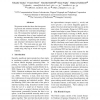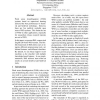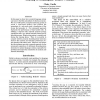143 search results - page 8 / 29 » Feature Disambiguation |
EMNLP
2007
13 years 9 months ago
2007
We present results that show that incorporating lexical and structural semantic information is effective for word sense disambiguation. We evaluated the method by using precise in...
IJCV
2007
13 years 7 months ago
2007
The neural mechanisms underlying motion segregation and integration still remain unclear to a large extent. Local motion estimates often are ambiguous in the lack of form features,...
ACL
2010
13 years 5 months ago
2010
Word sense disambiguation (WSD) systems based on supervised learning achieved the best performance in SensEval and SemEval workshops. However, there are few publicly available ope...
SAC
2005
ACM
14 years 1 months ago
2005
ACM
Because of name variations, an author may have multiple names and multiple authors may share the same name. Such name ambiguity affects the performance of document retrieval, web ...
AAAI
1992
13 years 8 months ago
1992
In this paper we show how a natural language system can learn to find the antecedents of relative pronouns. We use a well-known conceptual clustering system to create a case-based...



